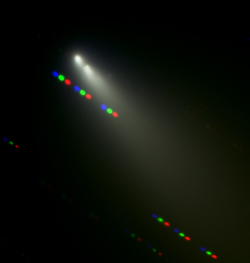The comet with a broken heart

Broken Fragments of Comet P73 / Schwassmann-Wachmann 3 (FORS/VLT). ESO Press Photo 15b/06 (25 April 2006) <br>Copyright: ESO
VLT takes images of disintegrating comet P73/Schwassmann-Wachmann 3
On the night of April 23 to 24, ESO’s Very Large Telescope observed fragment B of the comet Schwassmann-Wachmann 3 that had split a few days earlier. To their great surprise, the ESO astronomers discovered that the piece just ejected by fragment B was splitting again! Five other mini-comets are also visible on the image. The comet seems thus doomed to disintegrate but the question remains in how much time.
Comet P73/Schwassmann-Wachmann 3 (SW 3) is a body with a very tormented past. This comet revolves around the Sun in about 5.4 years, in a very elongated orbit that brings it from inwards the Earth’s orbit to the neighbourhood of giant planet Jupiter. In 1995, when it was coming ‘close’ to the Earth, it underwent a dramatic and completely unexpected, thousand-fold brightening. Observations in 1996, with ESO’s New Technology Telescope and 3.6-m telescope, at La Silla, showed that this was due to the fact that the comet had split into three distinct pieces. Later, in December 1996, two more fragments were discovered. At the last comeback, in 2001, of these five fragments only three were still seen, the fragments C (the largest one), B and E. No new fragmentations happened during this approach, apparently.
Things were different this time, when the comet moved again towards its closest approach to the Sun – and to the Earth. Early in March, seven fragments were observed, the brightest (fragment C) being of magnitude 12, i.e. 250 fainter than what the unaided can see, while fragment B was 10 times fainter still. In the course of March, 6 new fragments were seen.
Early in April, fragment B went into outburst, brightening by a factor 10 and on 7 April, six new fragments were discovered, confirming the high degree of fragmentation of the comet. On 12 April, fragment B was as bright as the main fragment C, with a magnitude around 9 (16 times fainter than what a keen observer can see with unaided eyes). Fragment B seems to have fragmented again, bringing the total of fragments close to 40, some being most probably very small, boulder-sized objects with irregular and short-lived activity.
The new observations reveal that this new small fragment has split again! The image clearly reveals that below the main B fragment, there is a small fragment that is divided into two and a careful analysis reveals five more tiny fragments almost aligned. Thus, this image alone shows at least 7 fragments. The comet has produced a whole set of mini-comets!
Will the process continue? Will more and more fragments form and will the comet finally disintegrate? How many new fragments will have appeared before the comet reaches its closest approach to the Sun, around 7 June, and how bright will they be when the comet will be the closest to the Earth, on 11 to 14 May?
Fragment C of the comet should be the closest to Earth on 11 May, when it will be about 12 million km away, while fragment B will come as ‘close’ as 10 million km from Earth on 14 May. Although this is the closest a comet ever approached Earth in more than twenty years – even Comet Hyakutake’s smallest distance was 15 million km – this is still 26 times the distance between the Earth and the Moon and therefore does not pose any threat to our planet.
If nothing else happens, at the time of closest approach, fragment B will be just visible with unaided eye by experienced observers. It should be an easy target however to observe with binoculars. If we are lucky, however, fragment B presents another outburst, becoming a magnificent sight in the night sky. On the other hand, it could just as well fade away into oblivion. But then, the main fragment C should still be visible, even possibly with the unaided eye.
ESO telescopes will observe the comet in the greatest detail at the end of May, when it is best observed from Chile and is brighter. These observations will obtain invaluable information, especially as the fragmentation process is revealing all the pristine material buried below the crust of the comet. As such, these observations will prove an ideal complement to the most comprehensive observation campaign made with ESO telescopes of Comet Tempel 1 when it was being bombarded by the Deep Impact spacecraft, on 4 July 2005.
Media Contact
More Information:
http://www.eso.org/outreach/press-rel/pr-2006/pr-15-06.htmlAll latest news from the category: Physics and Astronomy
This area deals with the fundamental laws and building blocks of nature and how they interact, the properties and the behavior of matter, and research into space and time and their structures.
innovations-report provides in-depth reports and articles on subjects such as astrophysics, laser technologies, nuclear, quantum, particle and solid-state physics, nanotechnologies, planetary research and findings (Mars, Venus) and developments related to the Hubble Telescope.
Newest articles

Silicon Carbide Innovation Alliance to drive industrial-scale semiconductor work
Known for its ability to withstand extreme environments and high voltages, silicon carbide (SiC) is a semiconducting material made up of silicon and carbon atoms arranged into crystals that is…

New SPECT/CT technique shows impressive biomarker identification
…offers increased access for prostate cancer patients. A novel SPECT/CT acquisition method can accurately detect radiopharmaceutical biodistribution in a convenient manner for prostate cancer patients, opening the door for more…

How 3D printers can give robots a soft touch
Soft skin coverings and touch sensors have emerged as a promising feature for robots that are both safer and more intuitive for human interaction, but they are expensive and difficult…





















